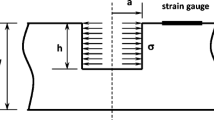Abstract
The hole-drilling method is used here to measure residual stresses in an orthotropic material. An existing stress-calculation method adapted from the isotropic case is shown not to be valid for orthotropic materials. A new stress-calculation method is described, based on the analytical solution for the displacement field around a hole in a stressed orthotropic plate. The validity of this method is assessed through a series of experimental measurements. A table of elastic compliances is provided for practical residual-stress measurements in a wide range of orthotropic materials.
Similar content being viewed by others
Abbreviations
- A, B, C :
-
calibration constants
- C ** :
-
orthotropic strain relief compliances
- E x ,E y :
-
elastic moduli along x and y (elastic symmetry) axes
- G xy :
-
x−y shear modulus
- m :
-
orthotropic elastic modulus ratio [eq (10)]
- r a :
-
hole radius
- r m :
-
mean radius of strain-gage rosette
- u, v :
-
displacements inx andy directions
- x, y :
-
coordinates along elastic symmetry axes
- W 1 ,W 2 :
-
geometrical parameters [eqs (14) and (15)]
- X 1 ,X 2 :
-
geometrical parameters [eqs (18) and (19)]
- Y 1 ,Y 2 :
-
geometrical parameters [eqs (20) and (21)]
- α, β:
-
orthotropic elastic material constants [eqs (12) and (13)]
- Υxy :
-
x−y Cartesian shear strain
- ɛ r :
-
measured relieved strain
- ɛ x , ɛ y :
-
x−y Cartesian normal strains
- θ:
-
counterclockwise angle measured from the x direction to the axis of the strain gage
- κ:
-
orthotropic elastic material constant [eq (11)]
- ν xy :
-
x−y Poisson's ratios
- σ x , σ y :
-
x−y Cartesian normal stresses
- σmax :
-
maximum (most tensile) principal stress
- σmin :
-
minimum (most compressive) principal stress
- τxy :
-
x−y Cartesian shear stress
- ϕ:
-
angle measured counterclockwise from thex direction to the direction of σmax
- ψ1, ψ2 :
-
geometrical parameters [eqs (16) and (17)]
References
Rendler, N.J. andVigness, I., “Hole-drilling Strain-gage Method of Measuring Residual Stresses,”Experimental Mechanics,6 (12),577–586 (1966).
Beaney, E.M., “Accurate Measurement of Residual Stress on any Steel Using the Centre Hole Method,”Strain,12 (3),99–106 (1976).
“Measurement of Residual Stresses by the Hole-drilling Strain-Gage Method,” Tech. Note TN-503-4, Measurements Group, Inc. Raleigh, NC (1993).
“Determining Residual Stresses by the Hole-Drilling Strain-Gage Method,” ASTM Standard E837-92, Amer. Soc. for Test. and Mat. (1992).
Schajer, G.S., “Application of Finite Element Calculations to Residual Stress Measurements,”J. Eng. Mat. and Tech.,103 (2),157–163 (1981).
Bert, C.W. andThompson, G.L. “A Method for Measuring Planar Residual Stresses in Rectangularly Orthotropic Materials,”J. Composite Mat.,2 (2),244–253 (1968).
Lake, B.R., Appl, F.J. andBert, C.W., “An Investigation of the Hole-drilling Technique for Measuring Planar Residual Stress in Rectangularly Orthotropic Materials,”Experimental Mechanics,10 (10),233–239 (1970).
Prasad, C.B., Prabhakaran, R. andThompkins, S., “Determination of Calibration Constants for the Hole-Drilling Residual Stress Measurement Technique Applied to Orthotropic Composites,”Composite Structures, Part I: Theoretical Considerations,8 (2),105–118 (1987);Part II: Experimental Evaluations,8 (3), 165–172 (1987).
Perry, C.C., “Data Reduction Algorithms for Strain-Gage Rosette Measurements,”Exp. Tech.,13 (5),13–18 (1989).
Hearmon, R.F.S., “An Introduction to Applied Anisotropic Elasticity,” Oxford Univ. Press (1961).
Schimke, J., Thomas, K. and Garrison, J., “Approximate Solution of Plane Orthotropic Elasticity Problems,” Scholarly (1970).
Kawamoto, T., “On the State of Stress and Deformation Around Tunnel in Orthotropic Elastic Ground,”Memoirs of the Faculty of Engineering, Kumamoto Univ., Japan,10 (1),1–30 (1963).
Becker, R.M., “An Anistropic Elastic Solution for Testing Stress Relief Cores,” U.S. Bureau of Mines, Report of Investigations 7143 (1968).
Smith, C.B., “Effect of Elliptic or Circular Holes on the Stress Distribution in Plates of Wood or Plywood Considered as Orthotropic Materials,” USDA Forest Products Lab., Mimeo 1510 (May 1944).
Schajer, G.S., “Use of Displacement Data to Calculate Strain Gauge Response in Non-Uniform Strain Fields,”Strain,29 (1),9–13 (1993).
Lekhnitskii, S.G., Anisotropic Plates, Gordon and Breach, New York (1968).
Abramowitz, M. andStegun, I.A., Handbook of Mathematical Functions, Dover, New York (1965).
Lineback, L.D., ESA Notebook, Measurements Group, Inc., Raleigh, NC 3,7–14 (May,1986).
Author information
Authors and Affiliations
Rights and permissions
About this article
Cite this article
Schajer, G.S., Yang, L. Residual-stress measurement in orthotropic materials using the hole-drilling method. Experimental Mechanics 34, 324–333 (1994). https://doi.org/10.1007/BF02325147
Received:
Revised:
Issue Date:
DOI: https://doi.org/10.1007/BF02325147




